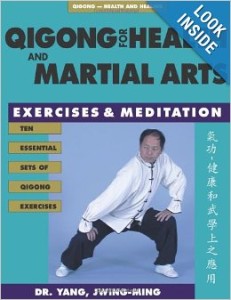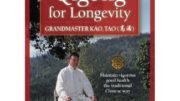 “Qigong for Health and Martial Arts” by Dr. Yang Jwing-Ming is not as long or comprehensive as many of his books, but it was not meant to be. In this 175 page manual, which is short compared to some of the lengthy tombs he’s written, Dr. Yang provides a very good introduction to the Chinese practice of Qigong, and includes various healing Qigong exercises and massage techniques that are found within the immense body of knowledge that makes up the Qigong cannon. For the person who wants a brief introduction to the health benefits of Qigong and how it can assist one in becoming a better martial artist, this is a good starting point and will most likely create an interest in learning more from an instructor or further resources.
“Qigong for Health and Martial Arts” by Dr. Yang Jwing-Ming is not as long or comprehensive as many of his books, but it was not meant to be. In this 175 page manual, which is short compared to some of the lengthy tombs he’s written, Dr. Yang provides a very good introduction to the Chinese practice of Qigong, and includes various healing Qigong exercises and massage techniques that are found within the immense body of knowledge that makes up the Qigong cannon. For the person who wants a brief introduction to the health benefits of Qigong and how it can assist one in becoming a better martial artist, this is a good starting point and will most likely create an interest in learning more from an instructor or further resources.
I’ll get the one negative out of the way right now. On the back cover, it states, “A complete guide to Qigong training for martial artists!” This statement is bold across the top, and while I understand marketing, this book is not a complete guide to Qigong for martial artists. It is an introduction, and in fact, inside the book, the chapter on martial arts applications is the shortest chapter, and Dr. Yang even states in the three paragraph conclusion, “Space has limited the presentation of the martial applications of Qigong, but the author hopes to publish more information on this matter in the future.” I still believe this to be a valuable book, an educational book, a book good for martial artists, but it is not a “complete” guide. I would suggest a martial artist new to Qigong start with this book, and then continue studying with other resources from Dr. Yang and others.
The first chapter contains a good introduction of Qigong. Even though I have studied various methods and resources, I still enjoyed this quick intro to refresh my education. The second chapter focuses on Wai Dan Qigong and the third chapter focuses on Nei Dan Qigong. Both chapters do a good job of explaining the theory behind the practice, the origins of the practice, benefits and how to perform certain exercises. Photographs, charts, and diagrams are used throughout the book to assist with learning. I felt the chapters were about right for a basic text. They were not too long or in depth, and after this introduction, some students will go further into study, but others may feel this is all they really need at this time.
Chapter four is on Qigong and Health and provides some basics regarding Chinese Traditional Medicine. Again, it is not meant to be a complete medical text, but a short introduction to some of the principles and how they relate to Qigong. This chapter includes some basics regarding massage techniques as well.
The fifth, and last chapter, is on Martial Arts Applications, and as I said above, it is the shortest chapter in the book. It contains a brief introduction and then a little on the areas of cavity press, sealing the vein and sealing the breath, and finally golden bell cover or iron shirt. The book also has a glossary of Chinese terms and an index.
While I don’t believe this to be a complete guide to Qigong training for the martial artist, I do believe it is very good starting point for the martial artist that does not know much about Qigong. It is a basic book, and a good primer at that. I suggest reading it first, and then continuing on with more advanced resources.



Be the first to comment on "Qigong for Health and Martial Arts by Dr. Yang Jwing-Ming"